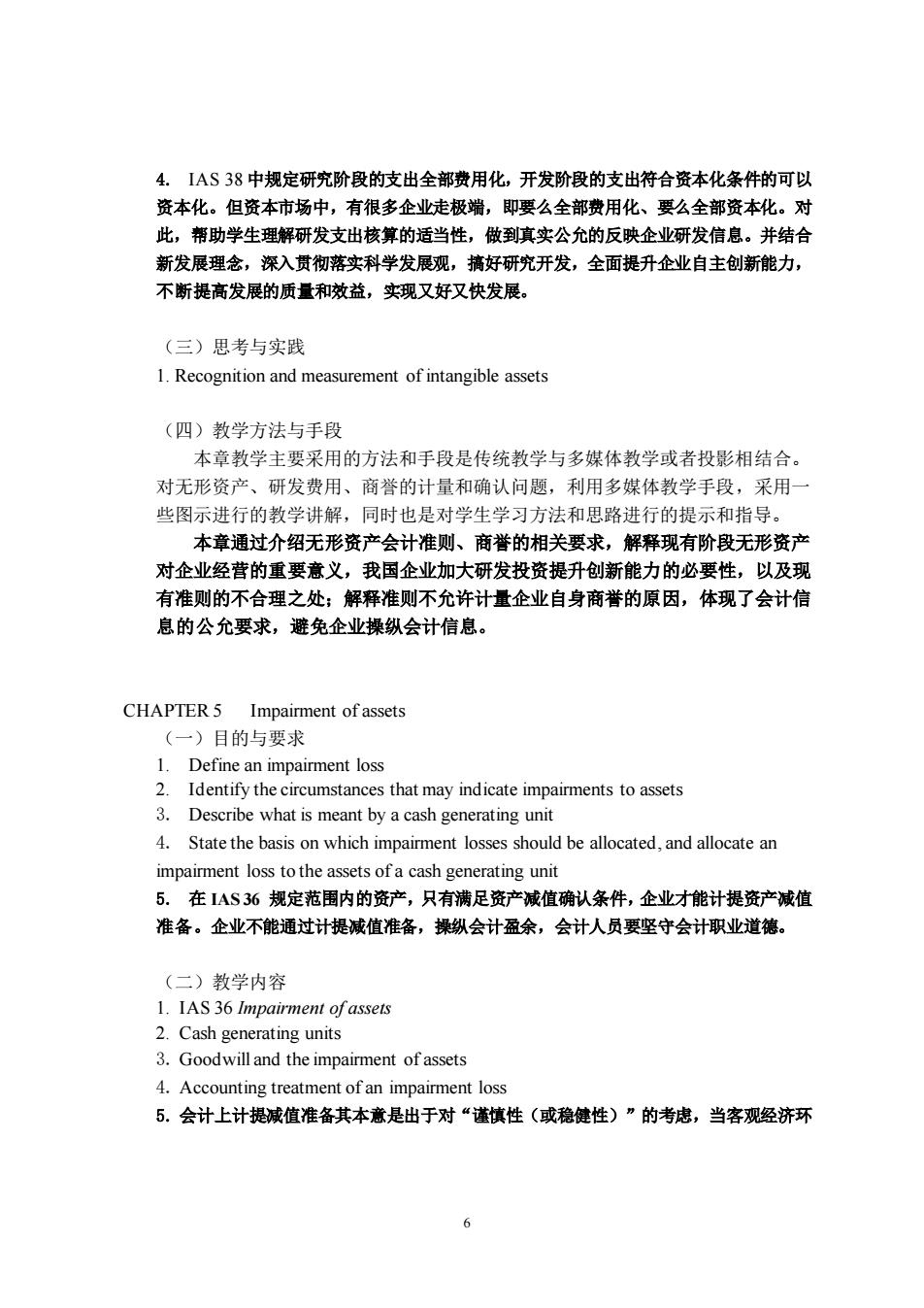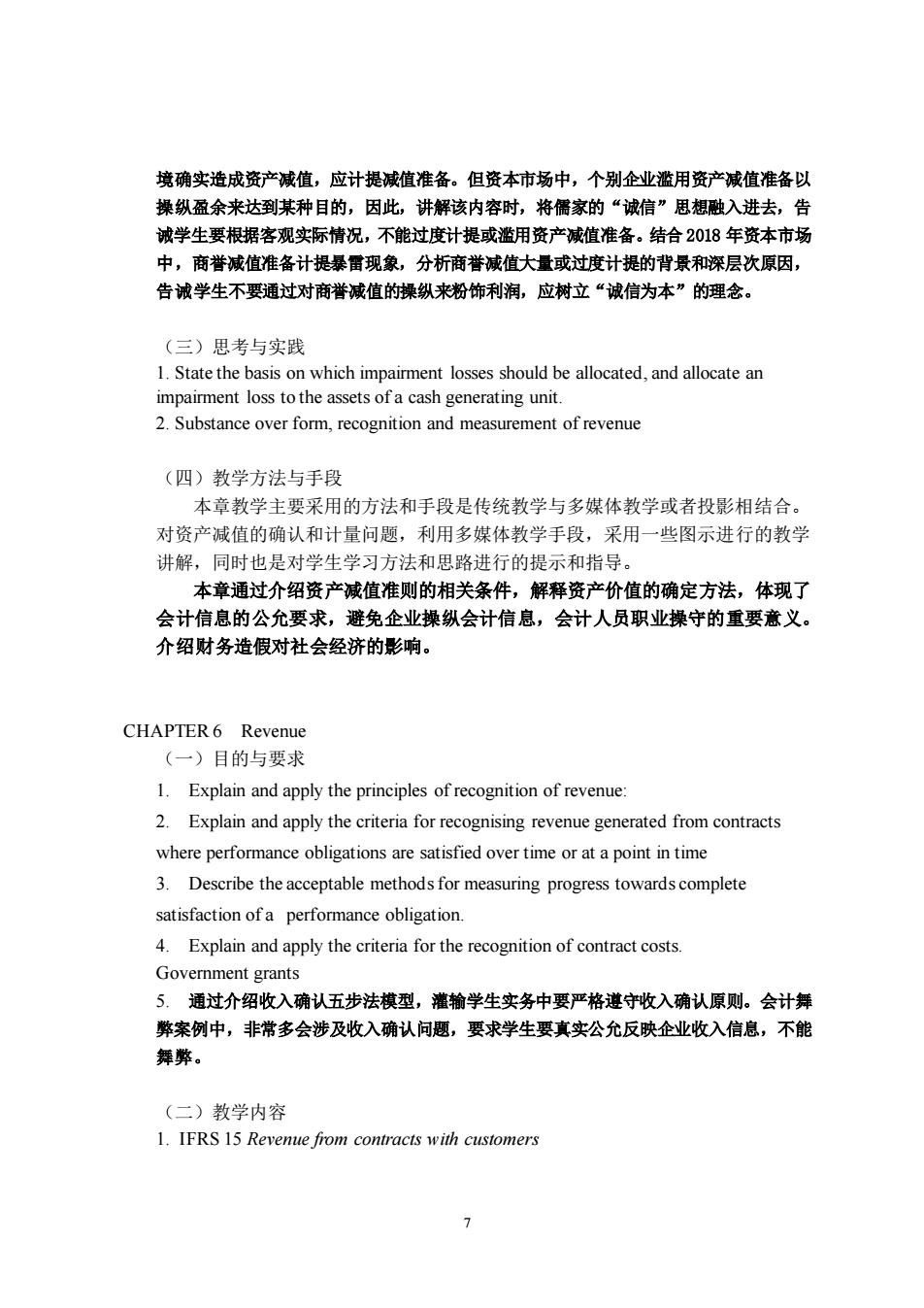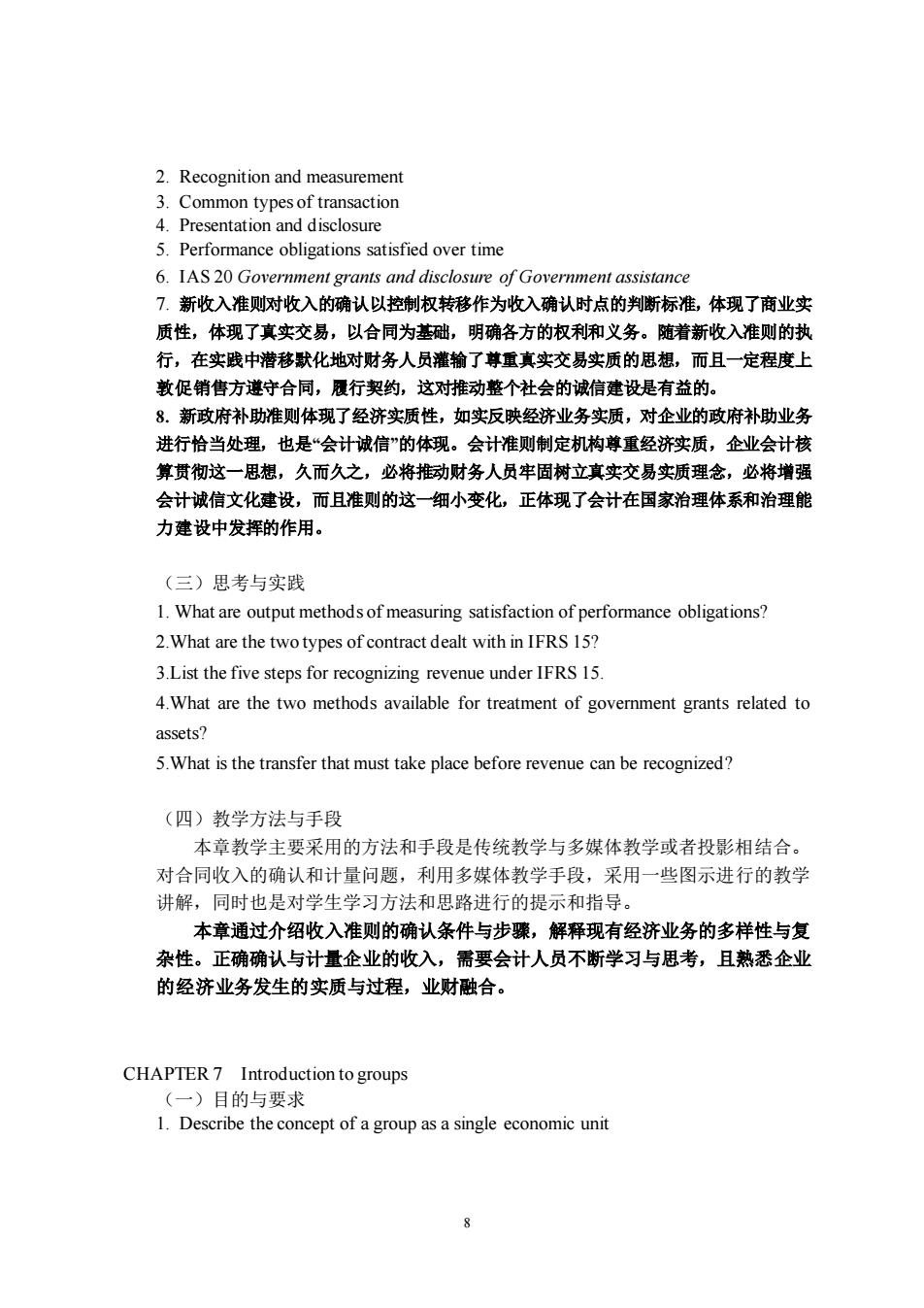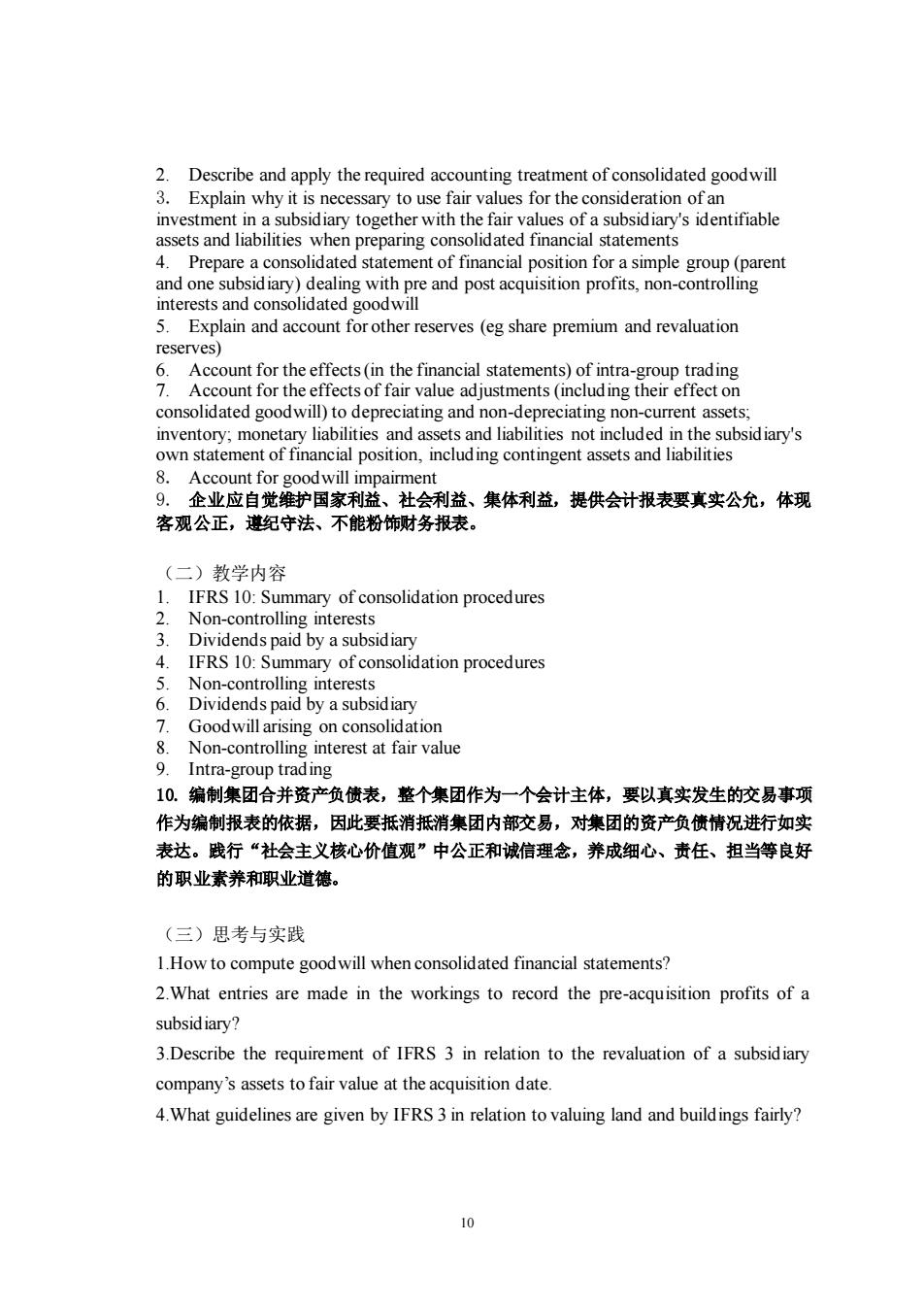
4.IAS38中规定研究阶段的支出全部费用化,开发阶段的支出符合资本化条件的可以 资本化。但资本市场中,有很多企业走极端,即要么全部费用化、要么全部资本化。对 此,帮助学生理解研发支出核算的适当性,做到真实公允的反映企业研发信息。并结合 新发展理念,深入贯彻落实科学发展观,搞好研究开发,全面提升企业自主创新能力, 不断提高发展的质量和效益,实现又好又快发展。 (三)思考与实践 1.Recognition and measurement of intangible assets (四)教学方法与手段 本章教学主要采用的方法和手段是传统教学与多媒体教学或者投影相结合。 对无形资产、研发费用、商誉的计量和确认问题,利用多媒体教学手段,采用 些图示进行的教学讲解,同时也是对学生学习方法和思路进行的提示和指导。 本章通过介绍无形资产会计准则、商誉的相关要求,解释现有阶段无形资产 对企业经营的重要意义,我国企业加大研发投资提升创新能力的必要性,以及现 有准则的不合理之处;解释准则不允许计量企业自身商誉的原因,体现了会计信 息的公允要求,避免企业操纵会计信息。 CHAPTER 5 Impairment of assets (一)目的与要求 1. Define an impairment loss 2.Identify the circumstances that may indicate impairments to assets Describe what is meant by a cash generating unit State the basis on which impairment losses should be allocated.and allocate an mpairment loss to the assets of a cash generating unit 5.在IAS6规定范围内的资产,只有满足资产减值确认条件,企业才能计提资产减值 准备。企业不能通过计提减值准备,操纵会计盈余,会计人员要坚守会计职业道德。 (二)教学内容 1.IAS 36 Impairment of assets 2.Cash generating units 3.Goodwill and the impairment ofassets 4.Accounting treatment ofan impairment loss 5。会计上计提减值准备其本意是出于对“谨慎性(或稳健性)”的考虑,当客观经济环 6
6 4. IAS 38 中规定研究阶段的支出全部费用化,开发阶段的支出符合资本化条件的可以 资本化。但资本市场中,有很多企业走极端,即要么全部费用化、要么全部资本化。对 此,帮助学生理解研发支出核算的适当性,做到真实公允的反映企业研发信息。并结合 新发展理念,深入贯彻落实科学发展观,搞好研究开发,全面提升企业自主创新能力, 不断提高发展的质量和效益,实现又好又快发展。 (三)思考与实践 1. Recognition and measurement of intangible assets (四)教学方法与手段 本章教学主要采用的方法和手段是传统教学与多媒体教学或者投影相结合。 对无形资产、研发费用、商誉的计量和确认问题,利用多媒体教学手段,采用一 些图示进行的教学讲解,同时也是对学生学习方法和思路进行的提示和指导。 本章通过介绍无形资产会计准则、商誉的相关要求,解释现有阶段无形资产 对企业经营的重要意义,我国企业加大研发投资提升创新能力的必要性,以及现 有准则的不合理之处;解释准则不允许计量企业自身商誉的原因,体现了会计信 息的公允要求,避免企业操纵会计信息。 CHAPTER 5 Impairment of assets (一)目的与要求 1. Define an impairment loss 2. Identify the circumstances that may indicate impairments to assets 3. Describe what is meant by a cash generating unit 4. State the basis on which impairment losses should be allocated, and allocate an impairment loss to the assets of a cash generating unit 5. 在 IAS 36 规定范围内的资产,只有满足资产减值确认条件,企业才能计提资产减值 准备。企业不能通过计提减值准备,操纵会计盈余,会计人员要坚守会计职业道德。 (二)教学内容 1. IAS 36 Impairment of assets 2. Cash generating units 3. Goodwill and the impairment of assets 4. Accounting treatment of an impairment loss 5. 会计上计提减值准备其本意是出于对“谨慎性(或稳健性)”的考虑,当客观经济环

境确实造成资产减值,应计提减值准备。但资本市场中,个别企业滥用资产减值准备以 操纵盆余来达到某种目的,因此,讲解该内容时,将衢家的“诚信”思想融入进去,告 城学生要根据客观实际待况,不能过度计提或滥用资产减值准备。结合2018年资本市场 中,商誉减值准备计提暴雷现象,分析商誉减值大量或过度计提的背景和深层次原因, 告斌学生不要通过对商誉减值的操纵来粉饰利润,应树立“波信为本”的理念。 (二)思若与实践 1.State the basis on which impairment losses should be allocated,and allocate an impairment loss to the assets of a cash generating unit. 2.Substance over form.recognition and measurement of revenue (四)教学方法与手段 本章教学主要采用的方法和手段是传统教学与多媒体教学或者投影相结合。 对资产减值的确认和计量问题,利用多媒体教学手段,采用一些图示进行的教学 讲解,同时也是对学生学习方法和思路进行的提示和指导。 本章通过介绍资产诚值准则的相关条件,解释资产价值的确定方法,体现了 会计信息的公允要求,避免企业操纵会计信息,会计人员职业操守的重要意义。 介绍财务造假对社会经济的影响。 CHAPTER6 Revenue (一)目的与要求 1.Explain and apply the principles of recognition of revenue 2.Explain and apply the criteria for recognising revenue generated from contracts where performance obligations are satisfied over time or at a point in time 3.Describe the acceptable methods for measuring progress towardscomplete satisfaction of a performance obligation 4.Explain and apply the criteria for the recognition of contract costs. Government grants 5.通过介绍收入确认五步法模型,灌输学生实务中要严格遵守收入确认原则。会计舞 弊案例中,非常多会涉及收入确认问题,要求学生要真实公允反映企业收入信息,不能 舞弊。 (二)教学内容 1.IFRS 15 Revenue from contracts with customers 7
7 境确实造成资产减值,应计提减值准备。但资本市场中,个别企业滥用资产减值准备以 操纵盈余来达到某种目的,因此,讲解该内容时,将儒家的“诚信”思想融入进去,告 诫学生要根据客观实际情况,不能过度计提或滥用资产减值准备。结合 2018 年资本市场 中,商誉减值准备计提暴雷现象,分析商誉减值大量或过度计提的背景和深层次原因, 告诫学生不要通过对商誉减值的操纵来粉饰利润,应树立“诚信为本”的理念。 (三)思考与实践 1. State the basis on which impairment losses should be allocated, and allocate an impairment loss to the assets of a cash generating unit. 2. Substance over form, recognition and measurement of revenue (四)教学方法与手段 本章教学主要采用的方法和手段是传统教学与多媒体教学或者投影相结合。 对资产减值的确认和计量问题,利用多媒体教学手段,采用一些图示进行的教学 讲解,同时也是对学生学习方法和思路进行的提示和指导。 本章通过介绍资产减值准则的相关条件,解释资产价值的确定方法,体现了 会计信息的公允要求,避免企业操纵会计信息,会计人员职业操守的重要意义。 介绍财务造假对社会经济的影响。 CHAPTER 6 Revenue (一)目的与要求 1. Explain and apply the principles of recognition of revenue: 2. Explain and apply the criteria for recognising revenue generated from contracts where performance obligations are satisfied over time or at a point in time 3. Describe the acceptable methods for measuring progress towards complete satisfaction of a performance obligation. 4. Explain and apply the criteria for the recognition of contract costs. Government grants 5. 通过介绍收入确认五步法模型,灌输学生实务中要严格遵守收入确认原则。会计舞 弊案例中,非常多会涉及收入确认问题,要求学生要真实公允反映企业收入信息,不能 舞弊。 (二)教学内容 1. IFRS 15 Revenue from contracts with customers

2.Recognition and measurement 3.Common types of transaction 4.Presentation and disclosure mmance obligations satisfied over time 6.IAS 20 Government grants and disclosure of Government assistance 7.新收入准则对收入的确认以控制权转移作为收入确认时点的判断标准,体现了商业实 质性,体现了真实交易,以合同为基础,明确各方的权利和义务。随着新收入准则的执 行,在实践中潜移默化地对财务人员灌输了尊重真实交易实质的思想,而且一定程度上 敦促销售方遵守合同,履行契约,这对推动整个社会的诚信建设是有益的。 8.新政府补助准则体现了经济实质性,如实反映经济业务实质,对企业的政府补助业务 进行恰当处理,也是“会计诚信”的体现。会计准则制定机构尊重经济实质,企业会计核 算贯彻这一思想,久而久之,必将推动财务人员牢固树立真实交易实质理念,必将增强 会计诚信文化建设,而且准则的这一细小变化,正体现了会计在国家治理体系和治理能 力建设中发挥的作用。 (三)思考与实践 1.What are output methods of measuring satisfaction of performance obligations? 2.What are the twotypes of contract dealt with in IFRS 15? 3.List the five steps for recognizing revenue under IFRS 15. 4.What are the two methods available for treatment of government grants related to assets? 5.What is the transfer that must take place before revenue can be recognized? (四)教学方法与手段 本章教学主要采用的方法和手段是传统教学与多媒体教学或者投影相结合。 对合同收入的确认和计量问题,利用多媒体教学手段,采用一些图示进行的教学 讲解,同时也是对学生学习方法和思路进行的提示和指导。 本章通过介绍收入准则的确认条件与步骤,解释现有经济业务的多样性与复 杂性。正确确认与计量企业的收入,需要会计人员不断学习与思考,且熟悉企业 的经济业务发生的实质与过程,业财融合。 Introduction to groups (一)目的与要求 1.Describe the concept of a group as a single economic unit 8
8 2. Recognition and measurement 3. Common types of transaction 4. Presentation and disclosure 5. Performance obligations satisfied over time 6. IAS 20 Government grants and disclosure of Government assistance 7. 新收入准则对收入的确认以控制权转移作为收入确认时点的判断标准,体现了商业实 质性,体现了真实交易,以合同为基础,明确各方的权利和义务。随着新收入准则的执 行,在实践中潜移默化地对财务人员灌输了尊重真实交易实质的思想,而且一定程度上 敦促销售方遵守合同,履行契约,这对推动整个社会的诚信建设是有益的。 8. 新政府补助准则体现了经济实质性,如实反映经济业务实质,对企业的政府补助业务 进行恰当处理,也是“会计诚信”的体现。会计准则制定机构尊重经济实质,企业会计核 算贯彻这一思想,久而久之,必将推动财务人员牢固树立真实交易实质理念,必将增强 会计诚信文化建设,而且准则的这一细小变化,正体现了会计在国家治理体系和治理能 力建设中发挥的作用。 (三)思考与实践 1. What are output methods of measuring satisfaction of performance obligations? 2.What are the two types of contract dealt with in IFRS 15? 3.List the five steps for recognizing revenue under IFRS 15. 4.What are the two methods available for treatment of government grants related to assets? 5.What is the transfer that must take place before revenue can be recognized? (四)教学方法与手段 本章教学主要采用的方法和手段是传统教学与多媒体教学或者投影相结合。 对合同收入的确认和计量问题,利用多媒体教学手段,采用一些图示进行的教学 讲解,同时也是对学生学习方法和思路进行的提示和指导。 本章通过介绍收入准则的确认条件与步骤,解释现有经济业务的多样性与复 杂性。正确确认与计量企业的收入,需要会计人员不断学习与思考,且熟悉企业 的经济业务发生的实质与过程,业财融合。 CHAPTER 7 Introduction to groups (一)目的与要求 1. Describe the concept of a group as a single economic unit

2.Explain and apply the definition of a subsidiary within relevant accounting 3.1d ntify and outline using accounting st eregulation the n a group required ed fi statements group n m the repaag wish ment solidate a subsidiary and when this is e ted by standards and othe plicable regulation 6 Explain the need fo otermino when preparing consolidated financial statements 7.Explain the objective of consolidated financial statements 8.正确理解母公司编制合并报表的合并范围,真实公允呈现企业集团财务状况、经营成果 的全貌,遵纪守法、强化责任担当, (二)教学内容 1 Groun accounts 2.Consolidated and separate financial statements Content of group acc unts and group structure 4。母公司编制合并报表的合并范围, 要以控制为判断依据,严格遵守准则规定。引用美 国安然事件作为案例,教导学生要敬畏法律、诚实守信、勇于担当社会责任。 (三)思考与实践 1.What accounting treatment does IFRS 10 require of a parent company? 2.How should an investment in a subsidiary be accounted for in the separate financial statements ofthe parent? 3.What is a non-controlling interest? (四)教学方法与手段 本章教学主要采用的方法和手段是传统教学与多媒体教学或者投影相结合。 对如何确认集团公司及合并财务报告问题,利用多媒体教学手段,采用一些图示 进行的教学讲解,同时也是对学生学习方法和思路进行的提示和指导。 本章通过介绍企业集团的特点,解释将一个企业集团作为一个会计主体提供 财务报表的必要性,避免企业采用设立多重子公司的形式,逃避法律监管,损害 投资者利益。 CHAPTER The consolidated statement of financial position (一)目的与要求 1.Explain why it is necessary to eliminate intra group transactions
9 2. Explain and apply the definition of a subsidiary within relevant accounting standards 3. Identify and outline using accounting standards and other applicable regulation the circumstances in which a group is required to prepare consolidated financial statements 4. Describe the circumstances when a group may claim exemption from the preparation of consolidated financial statements 5. Explain why directors may not wish to consolidate a subsidiary and when this is permitted by accounting standards and other applicable regulation 6. Explain the need for using coterminous year ends and uniform accounting policies when preparing consolidated financial statements 7. Explain the objective of consolidated financial statements 8. 正确理解母公司编制合并报表的合并范围,真实公允呈现企业集团财务状况、经营成果 的全貌,遵纪守法、强化责任担当。 (二)教学内容 1. Group accounts 2. Consolidated and separate financial statements 3. Content of group accounts and group structure 4. 母公司编制合并报表的合并范围,要以控制为判断依据,严格遵守准则规定。引用美 国安然事件作为案例,教导学生要敬畏法律、诚实守信、勇于担当社会责任。 (三)思考与实践 1.What accounting treatment does IFRS 10 require of a parent company? 2.How should an investment in a subsidiary be accounted for in the separate financial statements of the parent? 3.What is a non-controlling interest? (四)教学方法与手段 本章教学主要采用的方法和手段是传统教学与多媒体教学或者投影相结合。 对如何确认集团公司及合并财务报告问题,利用多媒体教学手段,采用一些图示 进行的教学讲解,同时也是对学生学习方法和思路进行的提示和指导。 本章通过介绍企业集团的特点,解释将一个企业集团作为一个会计主体提供 财务报表的必要性,避免企业采用设立多重子公司的形式,逃避法律监管,损害 投资者利益。 CHAPTER 8 The consolidated statement of financial position (一)目的与要求 1. Explain why it is necessary to eliminate intra group transactions

2 Describe and apply the required accounting treatment of consolidated goodwill Explain why it is necessary to use fair values for the consideration of an ary toge 0 a subsidiary's identifiable eparing coe po on to e group acquisition profits,non-contr ts and co pre and post Explain and account for other reserves (eg share premium and revaluation reserves) .coun or thefecto frasme (inunh Account for the effects (in the financial statements)of intra- oun trading consolidated goodwill)to depreciating and non-depreciating non-current assets; inventory;monetary liabilities and assets and liabilities not included in the subsidiary's own statement of financial position,including contingent assets and liabilities 8. Account for good will impairment 9. 企业应自觉维护国家利益、社会利益、集体利益,提供会计报表要真实公允,体现 客观公正,遵纪守法、不能粉饰财务报表。 (二)教学内容 N Summary of consolidation procedures mar of cons procedures Goodwill Non-controlling interest at fair value Intra oup trad ing 10.编制集团合并资产负债表,整个集团作为 一个会计主体,要以真实发生的较易事项 作为编制报表的依据,因此要抵消抵消集团内部交易,对集团的资产负债情况进行如实 表达。践行“社会主义核心价值观”中公正和诚信理念,养成细心、责任、担当等良好 的职业素养和职业道德。 (三)思考与实践 1.How to compute goodwill when consolidated financial statements? 2.What entries are made in the workings to record the pre-acquisition profits of a subsidiary? 3.Describe the requirement of IFRS 3 in relation to the revaluation of a subsidiary company's assets to fair value at the acquisition date. 4.What guidelines are given by IFRS3 in relation to valuing land and buildings fairly? 10
10 2. Describe and apply the required accounting treatment of consolidated goodwill 3. Explain why it is necessary to use fair values for the consideration of an investment in a subsidiary together with the fair values of a subsidiary's identifiable assets and liabilities when preparing consolidated financial statements 4. Prepare a consolidated statement of financial position for a simple group (parent and one subsidiary) dealing with pre and post acquisition profits, non-controlling interests and consolidated goodwill 5. Explain and account for other reserves (eg share premium and revaluation reserves) 6. Account for the effects (in the financial statements) of intra-group trading 7. Account for the effects of fair value adjustments (including their effect on consolidated goodwill) to depreciating and non-depreciating non-current assets; inventory; monetary liabilities and assets and liabilities not included in the subsidiary's own statement of financial position, including contingent assets and liabilities 8. Account for goodwill impairment 9. 企业应自觉维护国家利益、社会利益、集体利益,提供会计报表要真实公允,体现 客观公正,遵纪守法、不能粉饰财务报表。 (二)教学内容 1. IFRS 10: Summary of consolidation procedures 2. Non-controlling interests 3. Dividends paid by a subsidiary 4. IFRS 10: Summary of consolidation procedures 5. Non-controlling interests 6. Dividends paid by a subsidiary 7. Goodwill arising on consolidation 8. Non-controlling interest at fair value 9. Intra-group trading 10. 编制集团合并资产负债表,整个集团作为一个会计主体,要以真实发生的交易事项 作为编制报表的依据,因此要抵消抵消集团内部交易,对集团的资产负债情况进行如实 表达。践行“社会主义核心价值观”中公正和诚信理念,养成细心、责任、担当等良好 的职业素养和职业道德。 (三)思考与实践 1.How to compute goodwill when consolidated financial statements? 2.What entries are made in the workings to record the pre-acquisition profits of a subsidiary? 3.Describe the requirement of IFRS 3 in relation to the revaluation of a subsidiary company’s assets to fair value at the acquisition date. 4.What guidelines are given by IFRS 3 in relation to valuing land and buildings fairly?